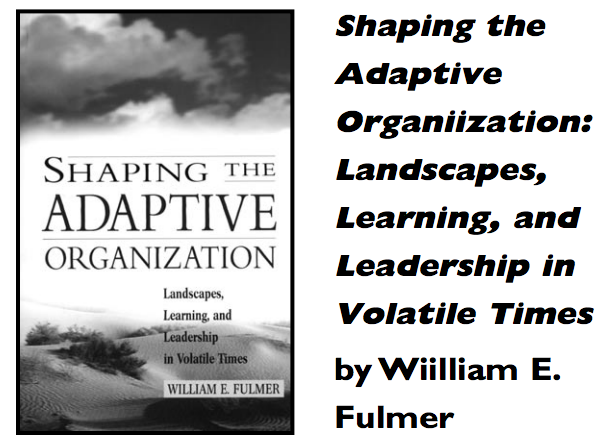
It is increasingly accepted that the metaphor of the organization as a complex adaptive system gives a better understanding of management issues than the established metaphor of the organization as a mechanism operating in a world tending to equilibrium. However, acceptance of the concept far outruns changes in practice. In Shaping the Adaptive Organization: Landscapes, Learning, and Leadership in Volatile Times (AMACOM, 2000), William E. Fulmer helps reinforce our understanding of what is implied by operating in a world of complexity. He offers simple ways of comprehending what he calls the business “landscape” and tools for building an organization that is effective in adapting to its context. This is not a one-time adaptation, but a profound transformation to a capacity to adapt continuously to changing conditions.
The book begins with a brief review of the rise of complexity theory and its application to business and economics. The key point is that we operate in a systemic world, in which relationships are usually non-linear. As a result, the consequences of our actions (and the actions of others) are, of their nature, unpredictable.
Thus, predicting the future is not just difficult but impossible. Our common response of meeting uncertainty with ever greater efforts at prediction and control is not just pointless but profoundly dangerous. The point is not that planning is useless—it is valuable—but that planning has to be done with the aim of equipping the organization and its people to deal with the unpredictable.
The Three Ls
Fulmer focuses his discussion on three major areas:
- the need to understand the “landscape” in which we operate and respond to it appropriately
- the need to pay attention to learning at all levels
- the role of the leader in creating an environment of success
Regarding the first topic, he asks organizations to consider the following questions:
- What is the relevant landscape in which they operate?
- How “rugged” is the landscape, that is, how high are the barriers to entry and so on?
- How fit is their organization to compete in this landscape?
The responses to these queries serve to inform the strategic planning process. According to the author, strategic planning must include:
- active observation;
- a deep understanding of the organization’s core competencies;
- scenario planning or other “what if?” tools;
- a clear direction that incorporates core values;
- a sense of opportunism within this framework; and
- a continual evolution of the process.
In order to change an organization’s culture, the author emphasizes encouraging individual learning and leveraging that learning by creating ways for people to share what they know. This process requires assigning genuine value—and therefore time— to these activities. It also requires an external focus; diversity; responsible risk taking; and openness, trust, and a sense of partnership throughout the organization.
A chapter on structure centers on the fact that complex adaptive systems function best “at the edge of chaos.” Fulmer states that “Structure influences strategy and strategy influences structure but both should be influenced by landscape.” According to the author:
- Decentralize and move decisionmaking to where the action is.
- Organize for people who can say “yes.”
- Use temporary structures (teams and project management) as much as possible, and form strategic alliances across organizational boundaries.
- Develop powerful informationand knowledge-exchange systems.
- Maintain flexibility in whatever structure you have so that it constantly evolves.
Finally, Fulmer encourages leaders to enact these precepts in order to create an environment of success:
- Build a network of relationships.
- Study the landscape.
- Set high expectations.
- Get out of people’s way.
- Be available.
- Choose the measures on which to focus (for example, the balanced scorecard).
- Communicate a direction.
- Be decisive, particularly on the hard decisions.
- Prepare a successor.
- Act with energy.
None of this is rocket science, nor are the ideas new, but they are well put together in a readable way. The devil, of course, is not so much in the detail as in achieving the change in mindset that allows the precepts to be put into effect.
Bill Godfrey is a management consultant and the founder of Bookwatch, a Web-based service that selects and reviews the best books for managers of change (http://www.bookwatch.com.au).
